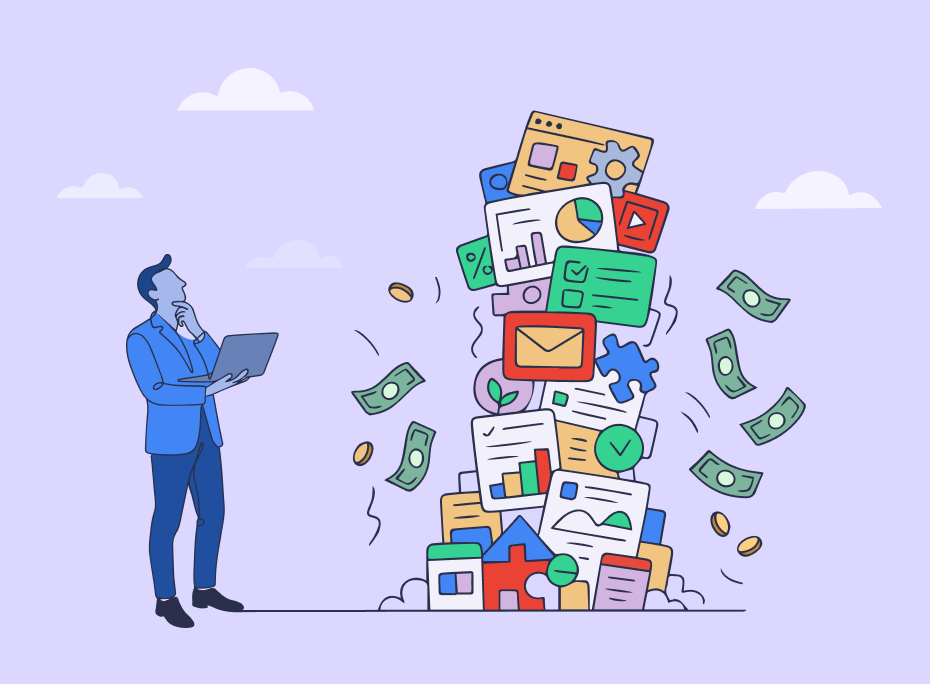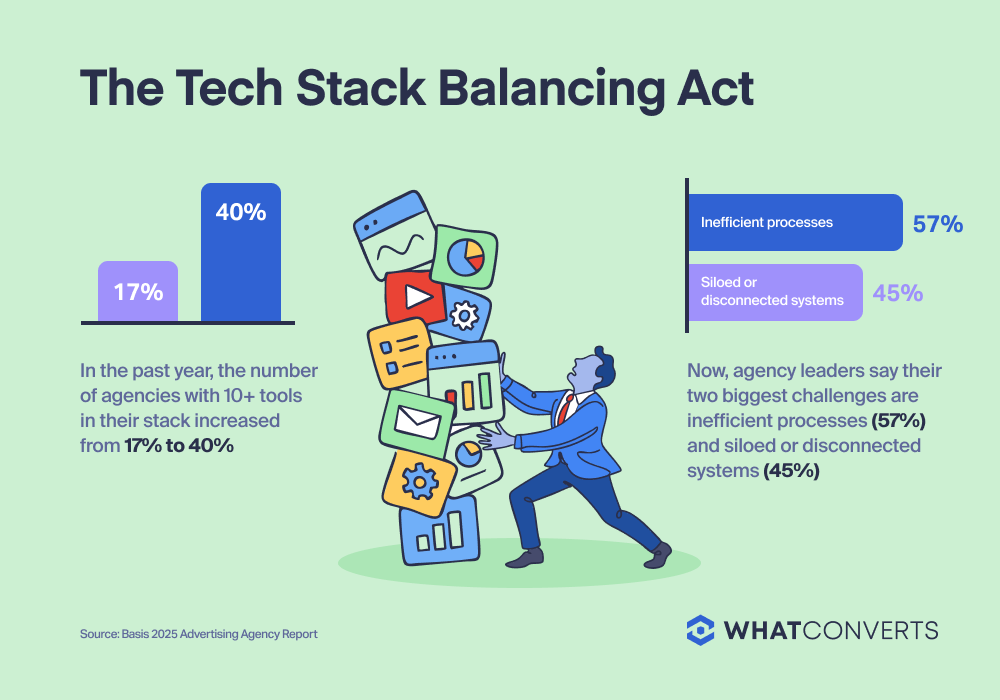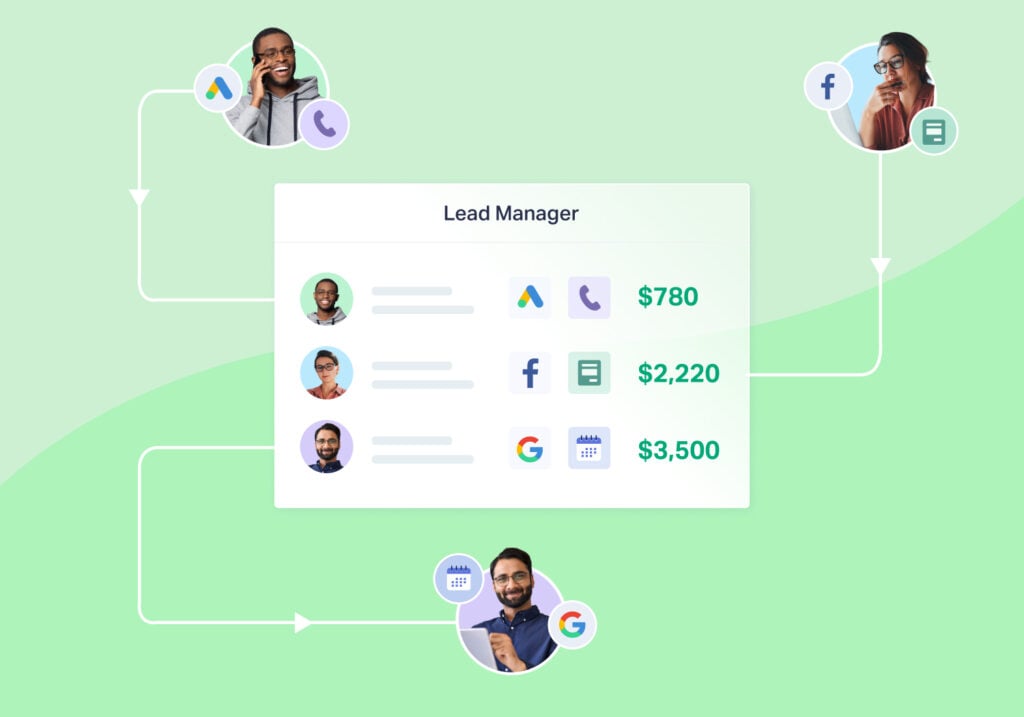
Each new tool solves a problem…until suddenly, your tech stack is the problem.
- A new call tracker to fix dynamic numbers.
- A form builder because the CRM’s forms are clunky.
- A chat tool for live leads.
- Another analytics platform because nothing syncs right.
Suddenly, integrations start breaking. Data fragments. Teams are wasting hours reconciling reports that don’t match.
This is a story that’s playing out across the industry: according to the Basis 2025 Advertising Agency Report, the number of agencies juggling 10+ tools jumped 131% over just 12 months.
But agency productivity didn’t see the same spike. In fact, inefficient processes are now the #1 challenge agencies face (56%), followed closely by rising costs (43%) and shrinking profits (43%).
The tools meant to make agencies faster and smarter are slowing you down and bleeding you dry. Unless you find a way to consolidate, your tech stack is going to topple—and take you down with it.
The Hidden Tax of Tool Sprawl
Every new platform promises to solve a problem. And individually, they often do.
But collectively, they create a different kind of chaos that shows up in ways agencies don’t measure:
- Context switching. To build one client report, your team logs into five different platforms. Each switch kills focus. Each export costs time.
- Data reconciliation. Campaign performance lives in one system. Call data in another. Form fills in a third. Building a single view means manually stitching together CSVs and praying you didn't double-count leads.
- Training overhead. New hires need to learn 10+ tools instead of three. Onboarding that should take days is starting to take weeks.
- Integration maintenance. APIs break. Webhooks fail. Someone on your team becomes the "tech stack therapist,” spending hours keeping connections alive instead of optimizing campaigns.
The result is that senior leaders now rank "siloed/disconnected systems" as their second-biggest challenge (45%), right behind inefficiency. The tools that were supposed to make work easier are now making it harder.
A Real-World Solution
Avita Digital faced exactly this problem. Managing multiple platforms for calls, forms, and chats meant their team spent hours each week reconciling data and building client reports.
After consolidating to WhatConverts, they cut reporting time by 60%. One platform replaced several tools—and gave them clearer ROI data to show clients.
Read More: Avita Digital Drives 50%+ CPA Reduction & Major Operational Savings [Case Study]
What Smart Agencies Are Doing Differently
The agencies avoiding this trap aren't necessarily spending less on technology. They're spending smarter—with consolidation as a core strategy. Here’s how:
- Audit ruthlessly. Before adding any new tool, ask: "What are we already paying for that does 80% of this?"
- Prioritize integration over features. A tool that connects seamlessly to existing systems beats a specialist tool that creates another data silo.
- Calculate true cost. Beyond licensing fees, they factor in setup time, training hours, maintenance overhead, and the productivity cost of context switching. A $200/month tool that saves 10 hours of manual work weekly is cheaper than a $50/month tool that creates new busywork.
- Consolidate by use case, not by channel. Instead of separate tools for each conversion type (calls, forms, chats), they're adopting platforms that unify lead tracking across all types. One dashboard. One source of truth. One place to prove ROI to clients.
The Unified Platform Advantage
This is where platforms like WhatConverts enter the picture—not as another tool to add, but as a replacement for several.
Instead of separate systems for:
- Call tracking
- Form capture
- Chat monitoring
- Lead management
- Marketing attribution
...agencies use a single platform that handles all conversion types, automatically connects them to marketing sources, and provides unified reporting.
The impact is immediate: Teams spend less time switching between tools and reconciling data. Reporting that used to take hours now takes minutes. And when a client asks "What's my ROI?" you have a confident answer—because all your conversion data lives in one place, attributed to actual marketing activity.
It's not about having fewer tools for the sake of minimalism. It's about eliminating the friction that's quietly draining your profitability.
The Real Cost of Doing Nothing
When your data lives in 10 different platforms, you can't quickly answer "Which campaigns drove revenue?" When reports take days because you're manually stitching together exports, you're not just wasting time—you're creating doubt.
Clients don't just want numbers. They want confidence.
The agencies solving this—through consolidation or unified platforms—aren't just saving money. They're building advantages:
- Faster reporting
- Clearer ROI
- Stronger client relationships
- Teams that focus on strategy instead of data wrangling
The question isn't whether to consolidate. It's how much longer you can afford not to.
If fragmented systems are slowing down your agency, it might be time to see what unified lead tracking looks like. Book a demo of WhatConverts or start your free trial and find out if consolidation could solve your efficiency problem.
Get a FREE presentation of WhatConverts
One of our marketing experts will give you a full presentation of how WhatConverts can help you grow your business.
Schedule a Demo
Grow your business with WhatConverts







